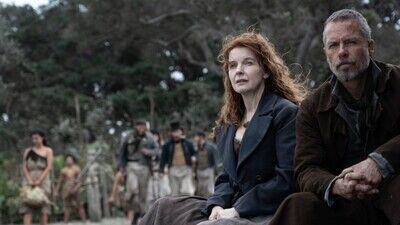Tamahori and co-writer Shane Danielsen may have taken some historical liberties in loosely basing their script on true events, creating composite characters or writing in new figures. Still, if the goal of “The Convert” was to give a sense of New Zealand when most of its residents called it by its Māori name, Aotearoa, then it is successful. Cinematographer Gin Loane frames Tamahori and Danielsen story with the gorgeous natural landscape around them, sometimes shooting in stark contrast to show off the dark sandy earth, inky rivers, and cloudy skies. In other moments, the camera revels in the crashing white waves, formidable rocky cliffs, and luscious green forests, occasionally moving in to focus on a bird or plant, grounding its story with a sense of place like no other. Thomas sees this part of the world for the first time, and the camera mirrors his curiosity. Likewise, the visual style is also used to heighten the narrative’s more dramatic scenes, like when Rangimai greets her father, the chief, after the murder of her husband. The reunion happens near the coastline, where the soil is dark, and the skies appear stormy, a harbinger for the battle forecast ahead.
“The Convert” is Tamahori’s third feature set in New Zealand. His breakout film “Once Were Warriors” introduced him to international audiences, and decades later, he returned with “Māhana,” a period piece following a Māori family in the 1960s. This trip back in time for “The Convert” is perhaps one of the more ambitious titles in his filmography, one painstakingly researched for accurate details to recreate Māori homes, costumes, and dialect, stocked with numerous extras and supporting characters to bring the last of the country’s pre-colonial days to the big screen. In that sense, the movie takes on a bittersweet note, bringing history to life in all its messy complexity – and the everyday players who shape it.

